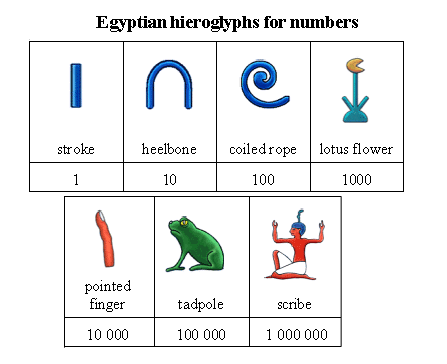History of Counting – II
We use counting in our day to day life. We count the number of idlies we eat, the number of glasses of water we drink. We count the money to buy chocolate in the shop. We count the number of eggs the hen laid. We count the number of books to take to school. We count the number of kilometres to reach the city. We use counting so much that we take it for granted. We forget that the method of counting we use today has to be invented. It took many centuries for counting to reach the present form.
Long, long ago, people did not count the way we do. Different people had different methods.
There was a group of people in Sri Lanka called Veddas. They were straightforward people who lived only on fruits and berries. They used only general terms like “a single”, “a couple”, “another one”, and “many” to count. When a Vedda wanted to count coconuts, he would collect some pebbles and keep one pebble for one coconut, and then he would keep one more pebble saying another one, then another one and finally would show the pebbles and say, “so many”.
There was another group of people called Papua in New Guinea. They did not create any unique words for counting at all. Whenever they wanted to count, they would show their body parts.
The left-hand little finger meant number 1; the left-hand ring finger was number 2, the left middle finger was 3, the left pointing finger 4, the left thumb was 5, the left-hand wrist was 6, the left-hand forearm was 7, the left-hand elbow was 8. Like this, they could count up to 28. When they had to bargain in the market, they would show their body parts.
Some used rope to count. They would tie a knot for every ‘One’ they counted. After counting, they would say so many.
The way we count is called “Abstract Counting”. First, humans might have counted by making a notch on the bone or stick—so many notches as many as the numbers of sheep. Then some people had sheep, goats, cows etc. they used different counters for different animals—a circular counter for counting sheep, oval for goat, triangular for cow etc.
Sumerians were the first people to use abstract counting. They used different symbols to represent one, ten and sixty. Along with these symbols, they used different symbols for different things.
Later on Phoenicians, who discovered the Alphabet, used the letters of alphabet for numbers. A represented 1, B =2, C=3, D=4, E=5, F=6, G=7, H=8, I =9, J=10, K =20, L =30, M = 40, N = 50, O=60, P=70, Q=80, R=90, S =100, T=200, U=300, V=400, W =500, X=600, Y=700,Z=800, ?= 800, ?=900
The Egyptians used special symbols for writing numbers. They could write up to 1000,000. Their symbols are:
=1 one finger
=10: A piece of rope.
=100: a coil of rope
=1000: a lotus or water lily
=10,000: a large finger
=100,000: a tadpole
=1000,000: a god called Heh


The Romans used some of the letters in their alphabet for numerals. So I = 1, V=5, X=10, L=50, C=100, D=500 and M=1000.
In Roman numerals
5945= MMMMMCMLXV
No one knows who and when the numerals we use were invented. These are called Arabic Numerals. They are:
0 1 2 3 4 5 6 7 8 9
They are called Arabic numerals because Arabs introduced them to Europeans. Arabs got them from India and called them “Hindu Numerals”.
Thus Indians were the first people to use Zero. A great Indian Mathematician called Aryabhatta used Zero in writing as early as 498 AD. It was called “Shoonya”. The numerals were
0 1 2 3 4 5 6 7 8 9
The use of zero made counting more accessible and limitless. We can count and write up to any number. The most significant digit is Googol. Googol = 1 followed by hundred zeros. If we needed to count beyond this, we could keep adding zeros like this: 10000000000000000000000000000000000000000000000000000000000000000000000000000000000000000000000000000000000000000000000000000000000000000000000000000000000000000000000000000000000000000000000000000000000000000000000…
Thus the counting has become limitless with the use of only ten numbers 0, 1, 2, 3, 4, 5, 6, 7. 8 and 9
Reference:
The History of Counting by Denise Schmandt – Besserat
